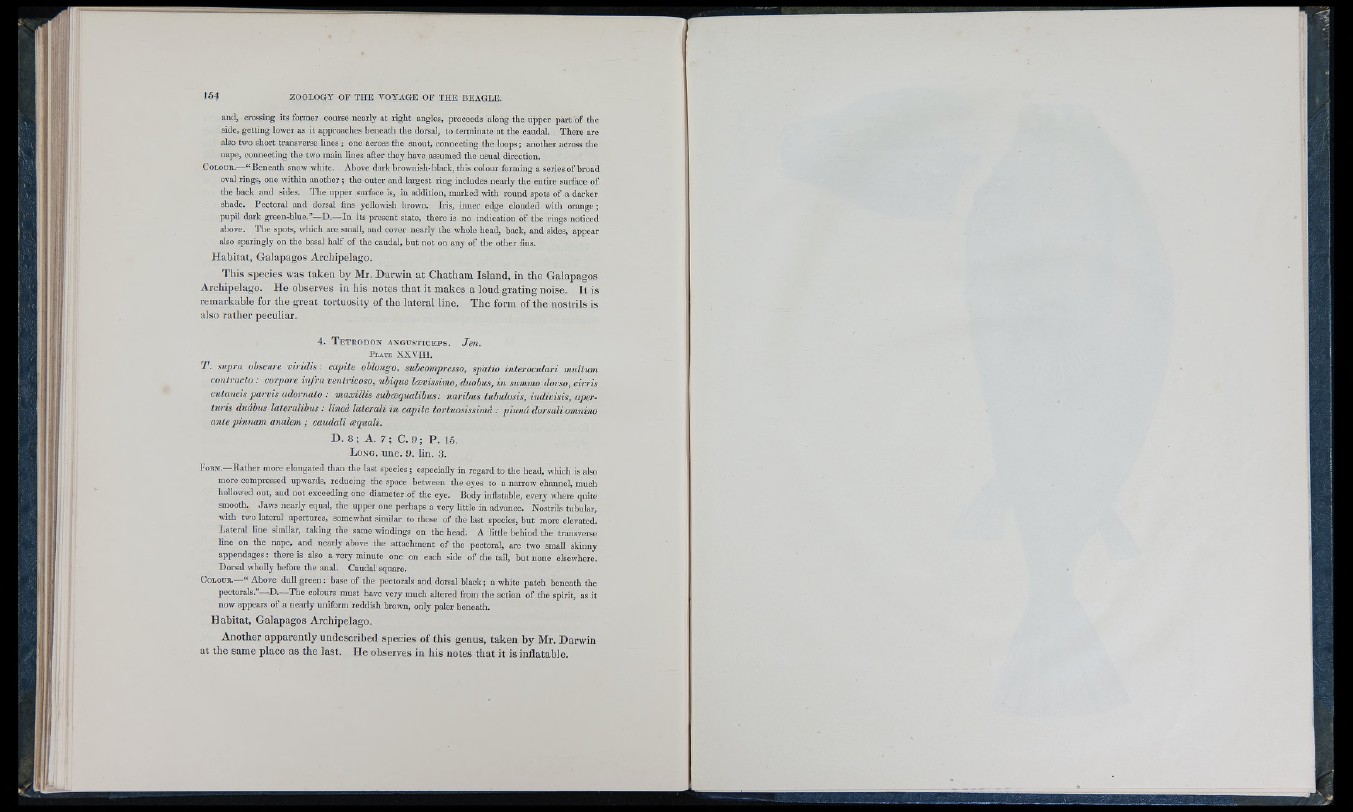
and, crossing its former course nearly at right angles, proceeds along the upper part of the
side, getting lower as it approaches beneath the dorsal, to terminate at the caudal. There are
also two short transverse lines ; one across the snout, connecting the loops; another across the
nape, connecting the two main lines after they have assumed the usual direction.
C o l o u r .—“ B eneath snow white. Above dark brownish-black, this colour forming a series of broad
oval rings, one within another ; the outer and largest ring includes nearly the entire surface of
the back and sides. The upper surface is, in addition, marked with round spots of a darker
shade. Pectoral aud dorsal fins yellowish brown. Iris, inner edge clouded with orange;
pupil dark green-blue.”—D .—In its present state, there is no indication of the rings noticed
above. T he spots, which are small, and cover nearly the whole head, back, and sides, appear
also sparingly on the basal half o f the caudal, but not on any of the other fins.
Habitat, Galapagos Archipelago.
This species was taken by Mr. Darwin at Chatham Island, in the Galapagos
Archipelago. He observes in his notes that it makes a loud grating noise. It is
remarkable for the great tortuosity of the lateral line. The form of the nostrils is
also rather peculiar.
4. T e t r o d o n a n g u s t i c e p s . Jen.
P l a t e X X Y III.
T . svpra obscure viridis : capite oblongo, suhconipx-esso, spatio interoculari midtum
contracto : corpore infra ventricoso, ubique loevissimo, duobus, in summo dorso, cirris
cutaneis parvis adornato : maxillis suhoequalibus : narihus tubulosis, indivisis, aper-
iuris duábus lateralibus : linea laterali in capite tortuosissimâ : pinnâ dorsali omnino
ante phuuim aiuilem ; caudali oequali.
D. 8 ; A. 7 ; C. 9; P . 15.
L o n g , im c . 9 . lin . 3.
F o rm .— R ather more elongated than the last species; especially in regard to the head, which is also
more compressed upwards, reducing the space between the eyes to a narrow channel, much
hollowed out, and not exceeding one diameter of the eye. Body inflatable, every where quite
smooth. Jaw s nearly equal, the upper one perhaps a very little in advance. Nostrils tubular,
w ith two lateral apertures, somewhat similar to those of the last species, but more elevated.
Lateral line similar, taking the same windings on the head. A little behind the transverse
line on the nape, and nearly above the attachm ent o f the pectoral, are two small skinny
appendages : there is also a very minute one on each side of the tail, but none elsewhere.
Dorsal wholly before the anal. Caudal square.
C o l o u r .— “ Above dull green: base of the pectorals and dorsal black ; a white patch beneath the
pectorals.”- D .—T he colours must have very much altered from tho action of the spirit, as it
now appears of a nearly uniform reddish brown, only paler beneath.
Habitat, Galapagos Archipelago.
Another apparently undescribecl species of this genus, taken by Mr. Darwin
at the same place as the last. He observes in his notes that it is inflatahle.